Podocarpus care and growing guide – expert tips for these coniferous trees
Podocarpus is an on-trend evergreen conifer that works well with most backyard styles


Podocarpus is a conifer that’s caught the eye of garden designers in recent years. Its characteristic fine, narrow foliage has an elegant feel, and it’s been seen at garden shows in contemporary planting schemes, alongside dwarf pines and cryptomeria.
Members of the podocarpus genus come in different sizes, colors, and foliage shapes, so can be used as privacy trees, specimen trees, ground cover plants, and more. There are varieties that suit all sorts of backyards, provided you’re in USDA zones 7-11. Some are reminiscent of pine and yew, others of willow, hence the common names of Japanese yew, willow-leaf podocarp and Buddhist pine. They’re all low-maintenance and can tolerate a range of environments.
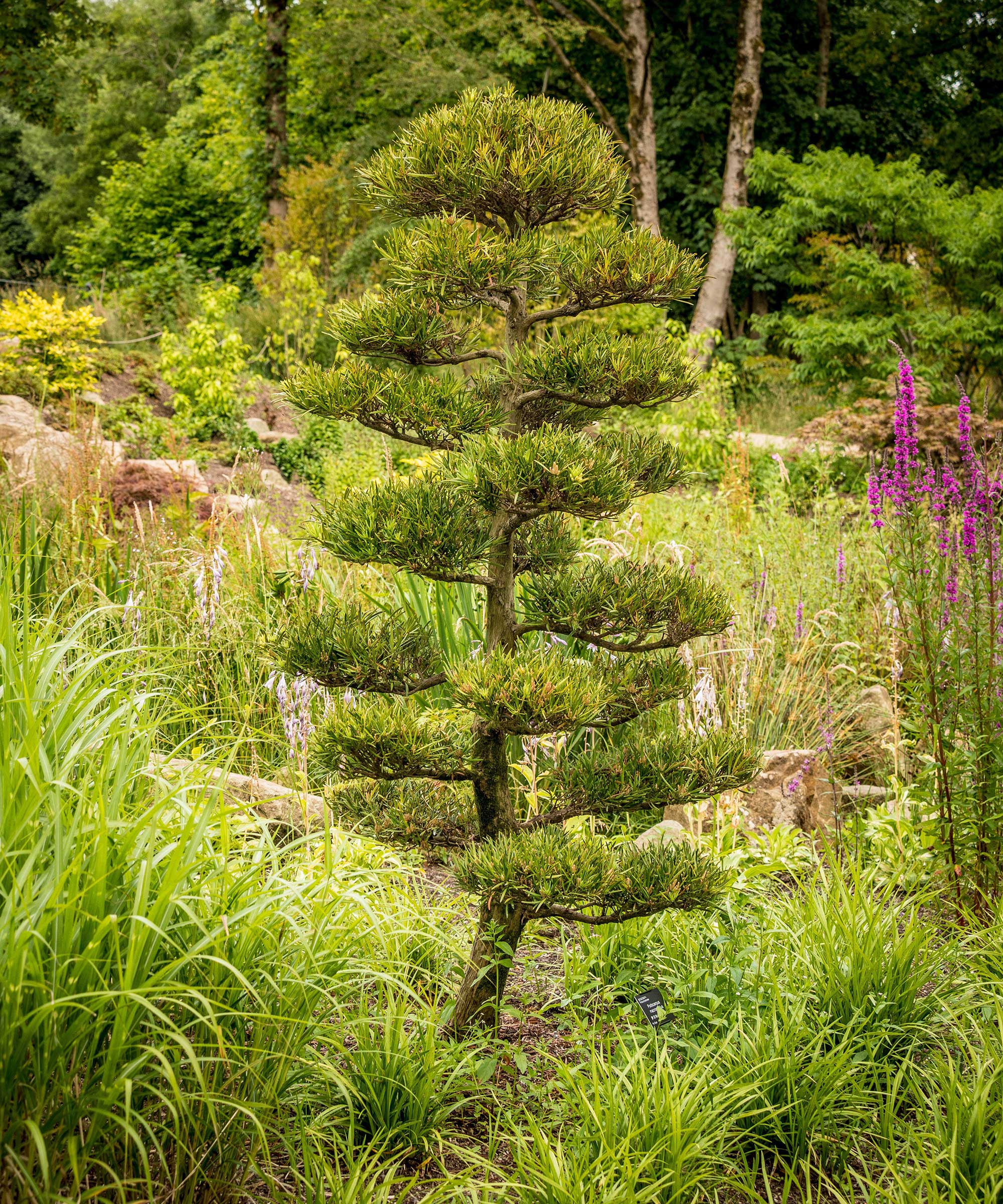
A cloud pruned Podocarpus macrophyllus
Podocarpus key facts:
- Plant type: Evergreen conifers, trees or shrubs
- Mature size: Various, from 3ft dwarf types to 82ft giants
- Soil type: Light sandy, loam, average
- Soil pH: Acid, neutral, alkaline
- Time of year to plant: Spring or fall
- Flowering time of year: Seed and pollen cones in summer
- Fruiting time of year: Seed cones turn berry-like in fall, but only where male and female plants are found together
- Growth rate: Slow to moderate
- Hardiness zones: USDA 7-11, depending on species
- Scientific name: Podocarpus
- Common names: Buddhist pine, Japanese yew, southern yew, plum pine, fern pine
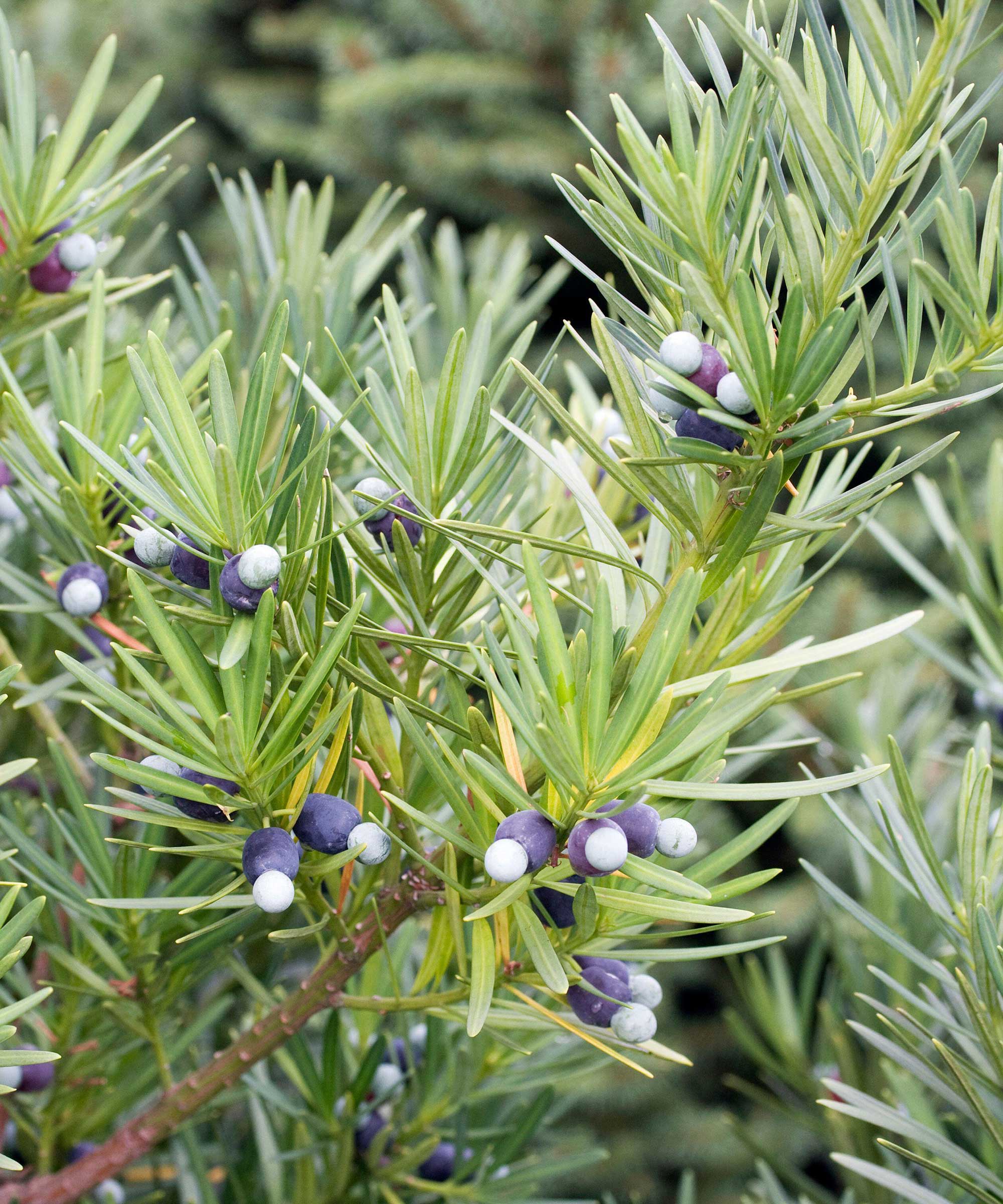
Podocarpus macrophyllus 'Edgefield'
Types of podocarpus
Podocarpus is the second largest conifer genus after pines, with over 100 species. A good range of podocarpus varieties are suitable for growing as backyard trees and shrubs, from ground-covering varieties that only reach 3ft high to lofty specimen trees that get to 15-20ft and beyond.
Here are some varieties to consider:
- Podocarpus macrophyllus: A top choice of podocarp, P. macrophyllus is favored for its versatility as much as for its good looks. It has acquired several different common names over time – Chinese podocarp, southern yew and Buddhist pine to name but a few. When allowed to grow as a tree, it can reach 15-20ft tall over 10-20 years, but sometimes twice that height over a very long period of time. It can also be maintained at a much shorter height as a hedging plant, screen or topiary specimen.
Several varieties are worth looking out for: ‘Roman Candle’ has eye-catching variegated white to light green new growth, while ‘Mood Ring’ has pretty bronzy-pink new growth that turns green as it matures. ‘Maki’ is a medium-sized variety that will accommodate smaller spaces, reaching 8-10ft tall and 3-4ft wide in 10-20 years. ‘Pringles’ is even shorter at 3-4ft and can be clipped to be maintained at half that height.
P. macrophyllus thrives in the warmth of the southern US and tolerates dry spells, but when grown in areas colder than USDA zone 8, plants can struggle with winter freezes.
It’s a great choice for cloud pruning (a Japanese method of pruning and shaping trees into cloud shapes). Paramount Plants Nursery says it ‘makes an interesting statement in the garden and has a more exotic appearance than other cloud trees with its long wide needles.’ - Podocarpus salignus: This Chilean native ‘is by far the most elegant and distinct of all the podocarps,’ says TreesAndShrubsOnline.org. What makes this species stand out is its glossy willow-like leaves up to 6in in length; they make excellent background foliage for flower arrangements. Cistus Nursery in Portland, Oregon says ‘it eventually grows to 25-30ft, but more reasonably to 15ft in the garden and is frost hardy in USDA zone 8.' Like P. macrophyllus, it's suitable for growing as a hedge and can be cloud pruned.
- Podocarpus henkelii: This south African native is popular in southern California. It's a very beautiful tree with graceful, long shiny leaves on sweeping branches. It can soar to 25-35ft tall by 15-25ft wide, but it can be kept much smaller by diligent pruning. A perfect variety for hedges or screening. In terms of hardiness, it suits USDA zones 9-10.
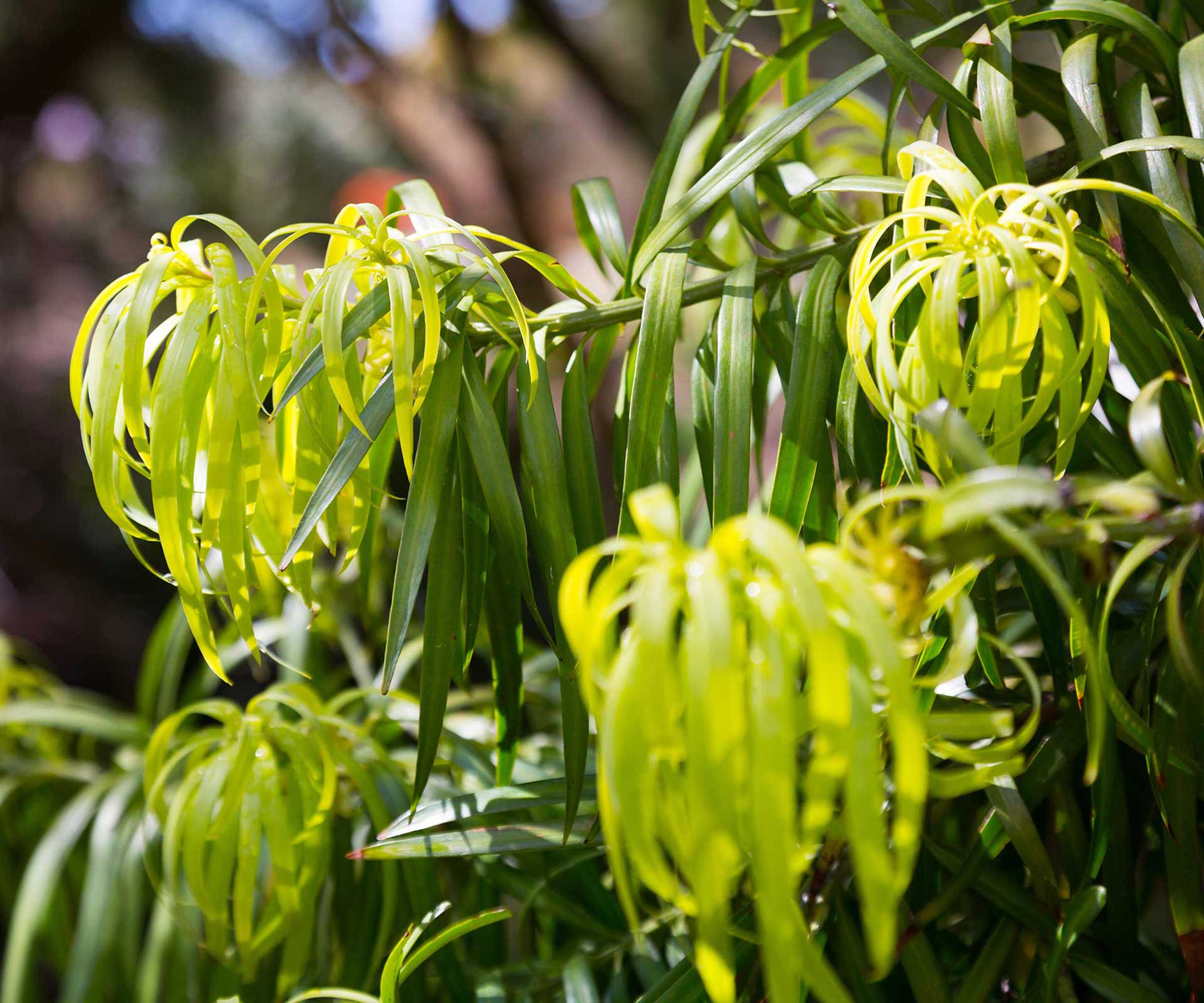
Podocarpus henkelii has elegant foliage
- Podocarpus nivalis: Also known as alpine totara, this plant has needle-like, dark green foliage and forms a dense, low-spreading mound. Unlike many conifers, it responds well to being cut back into old wood and makes a great low hedge to 3ft that can be regularly sheared. Unpruned, it also makes an excellent tall ground cover plant under large trees. ‘The dwarf podocarps (P. nivalis, P. lawrencei) have their origins in the sub-alpine regions of New Zealand and Tasmania and are superb conifers for the small garden,' says Ashwood Nurseries in the UK.
- Podocarpus 'Chocolate Box': A conifer with densely-held, glossy needles which deepen to dark mahogany in winter and in new growth. It could make a good boxwood alternative and is fabulous in containers or at the front of borders. Cistus Nursery says ‘the dwarf species are the hardiest members of the podocarpus genus,’ – they're frost hardy in USDA zone 7.
- Podocarpus elongatus ‘Icee Blue’: This is the first podocarpus tree with distinctive blue foliage, according to Monrovia Plants Nursery. ‘It’s one of the most beautiful and decorative pyramidal conifers for the South. An excellent specimen, lawn or screen tree.' Suitable for USDA zones 9-11.
- Podocarpus matudae: This Mexican podocarp, with a hardiness rating of USDA zones 8-9, is ‘showing great promise as a tree for mild gardens,’ says TreesAndShrubsOnline.org. Plants are cultivated under the name Podocarpus reichei in California and Oregon.
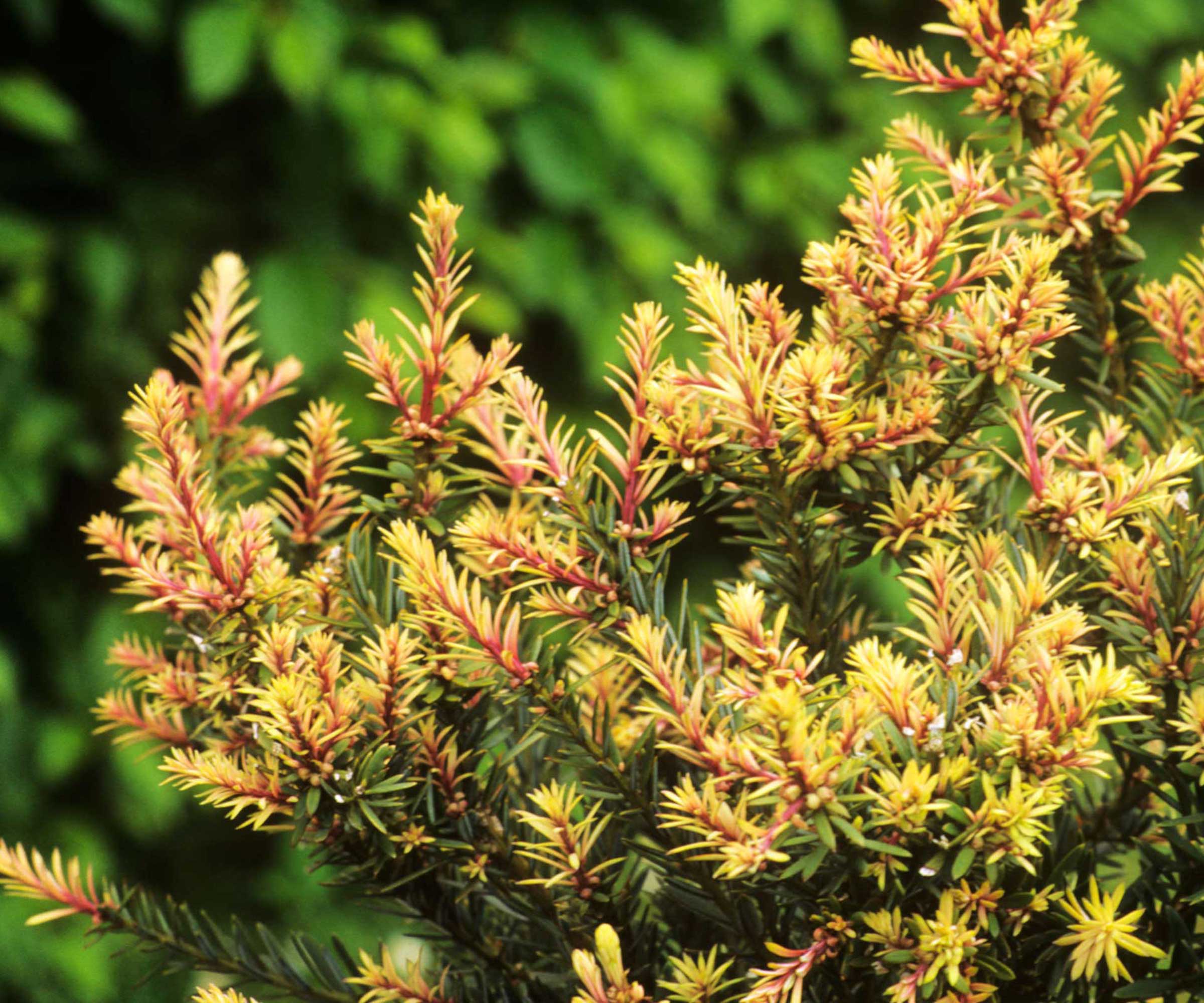
Podocarpus 'County Park Fire' is a dwarf variety with colorful foliage
How to use podocarpus in your backyard
Podocarpus is a super versatile evergreen tree when it comes to planting schemes and styles. Just make sure it’s positioned somewhere that gets sun for most of the day and where there’s shelter from cold winds.
It blends well in mixed borders with other plants that enjoy similar growing conditions such as ceanothus, nandina, hebe and acacia. Its narrow evergreen foliage and naturally bushy habit work particularly well with jungle-themed gardens alongside cannas and palms, and in Japanese garden schemes with bamboos and acers.
You can also use podocarpus to hide an unsightly fence. It grows moderately fast, so it’s not a hedge-in-a-hurry like arborvitae. But, it’s worth the wait, as the foliage is so lovely. Begin pruning when plants have been in the ground for at least a year, clipping in spring or midsummer to keep plants nice and bushy.
When left unpruned, podocarpus are superior specimen trees for shade. They’ll eventually grow up to be tall trees, so if you’re not planning on doing any pruning, ensure you have a large enough yard for them. ‘Their evergreen foliage is ideal screening against neighboring second-story windows, and it’s a nearly litter-free tree for swimming pool areas and driveways,’ says Monrovia Plants Nursery. The American Conifer Society suggests removing the lower branches when growing it as a specimen tree to reveal the attractive light brown bark.
With pruning, or by selecting shorter varieties like Podocarpus ‘Maki’, it’s a superior choice for smaller suburban backyards, too. In contemporary settings it looks particularly good as a multi-stemmed tree or cloud pruned, and partners up well with other modern plants like phormium, festuca grass, senecio and asparagus ferns.
The hardier dwarf podocarpus are great trees for small gardens and for those at the outer reaches of its growing range (USDA zone 7). Dwarf podocarpus are suitable for rock gardens, patio pots, at the front of the border or as ground cover and can be used to make a very good low hedge, says Ashwood Nursery. 'Naturally growing into a low dome-shaped mound, they can be easily trimmed into shape (much as you would trim yew), best carried out in spring for maximum foliage effect.'
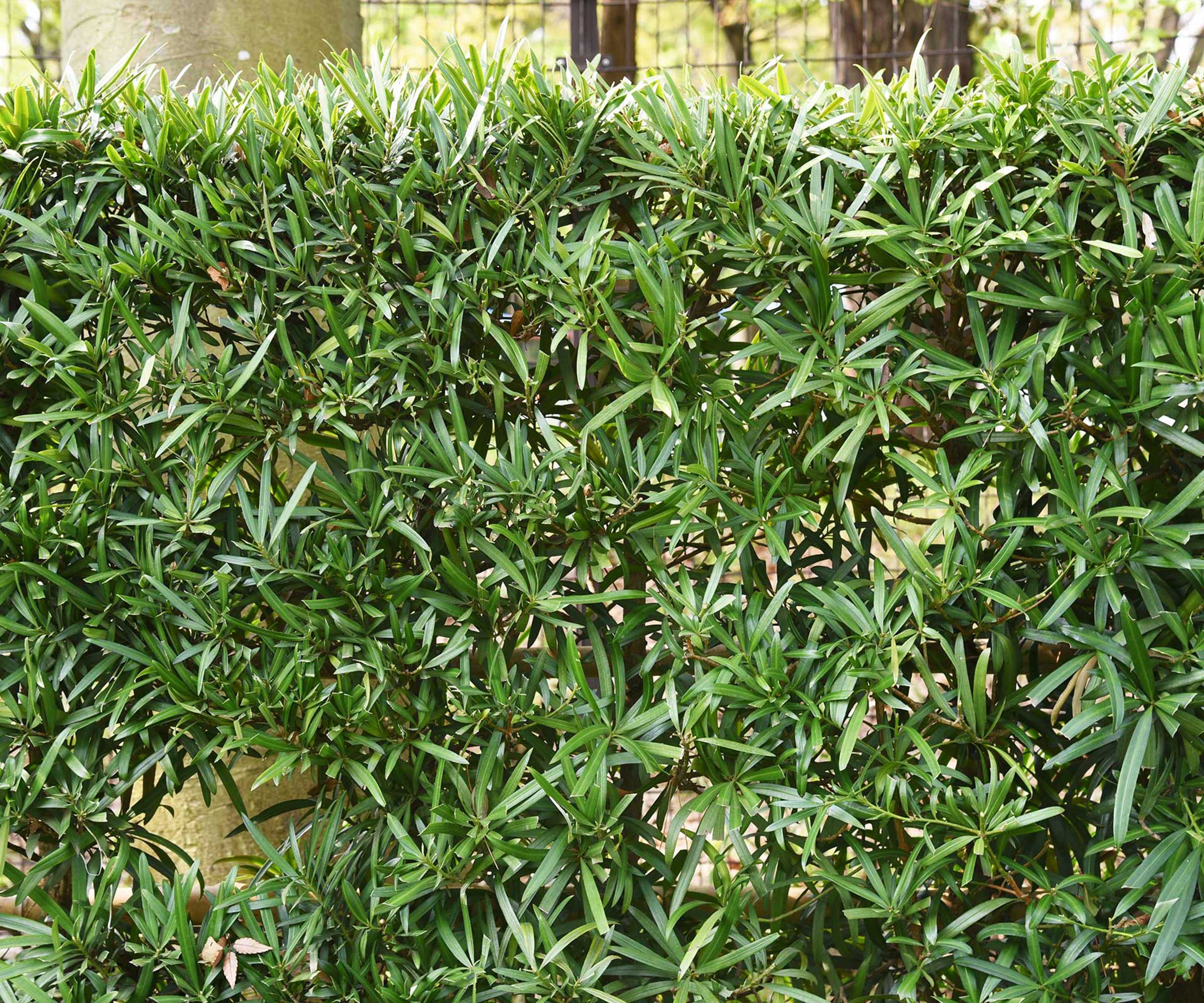
Podocarpus macrophyllus can be grown as a hedge
When, where and how to plant podocarpus
Early spring and early fall are the best times to plant conifers. Fall is preferable, as the soil is still warm from summer. Avoid planting anything when the soil is frozen or during hot, dry weather.
The ideal location would be an area where the plant receives six hours of sunlight per day. The experts at Caerhays Garden in Cornwall, UK, which has the national collection of podocarpus, says ‘greens will do best with some shade but the colored leaf forms perform best in full sun.’ Your chosen site should also have average to well-drained fertile soil with average moisture.
‘If the soil in the planting area is compacted, dig it over to loosen it,’ says the RHS. This will encourage the conifer’s roots to spread out. With heavy or sandy soils, dig in organic matter such as garden compost around the planting area (not in the planting hole) to improve the soil’s structure.
When planting, the point where the roots flare out from the stem should be level with the surrounding soil. On container-grown plants, scrape away the compost from the top of the rootball to reveal this point. If planting a hedge, space plants 3ft apart.
Podocarpus plants have the special advantage of naturally occurring nodules on their roots that help the plant store nitrogen. So, they'll grow even in the poorest soil conditions where nitrogen is deficient (nitrogen is what keeps plants looking healthy and green). Because they’re not heavy feeders, podocarpus will thrive without additional feeding. However, the RHS recommends applying a general-purpose granular feed (available on Amazon) in the spring for optimum performance.
The conditions podocarpus doesn’t like are thin chalk, cold, drying winds, waterlogged soil and too much shade. If the plant is grown in too much shade, it will become leggy (long and thin) and won’t grow as dense.
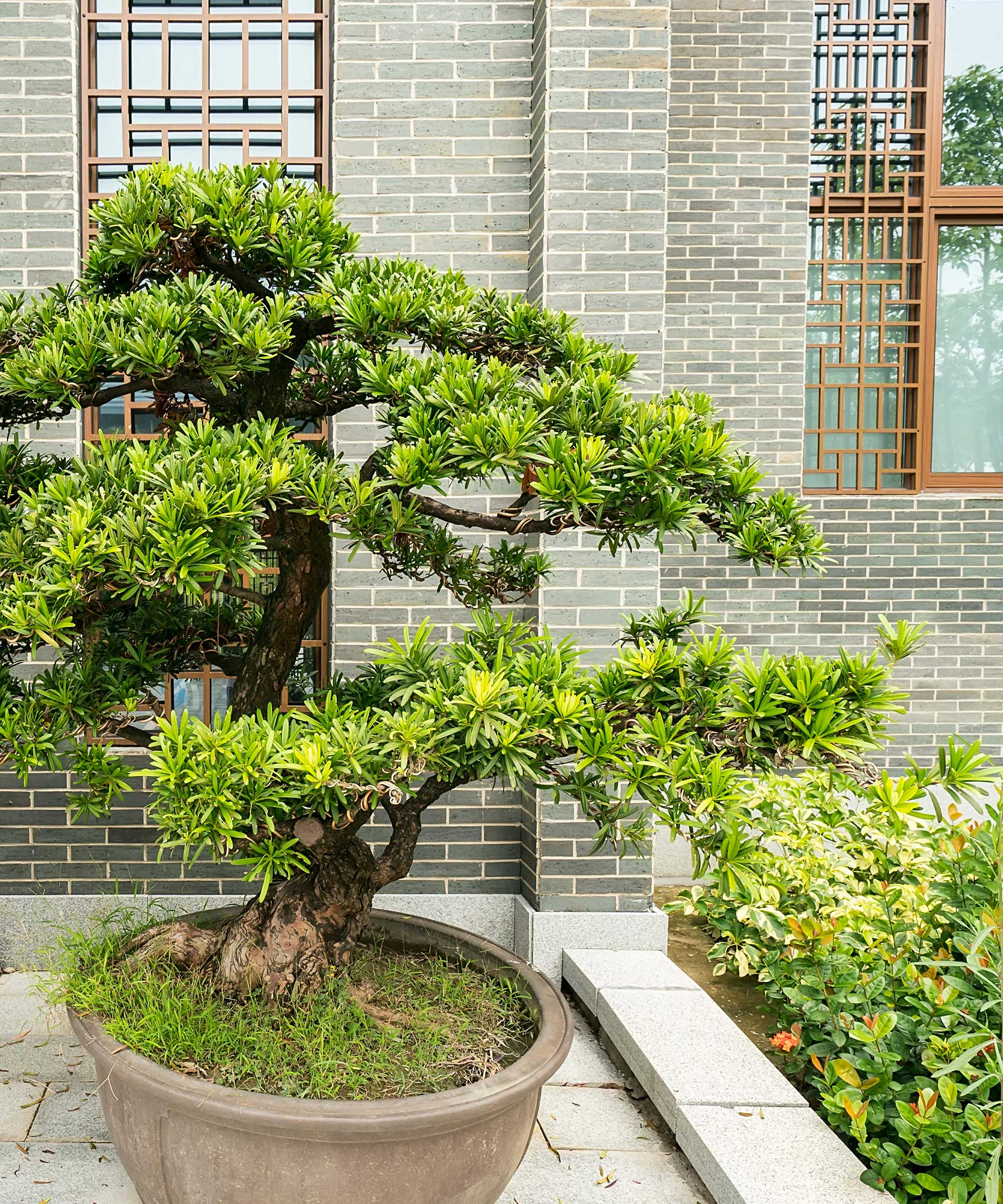
Some podocarpus varieties work well in containers
How to make more podocarpus
Podocarpus are very easy plants to propagate from cuttings. These should be taken in late summer to early fall, when the new growth has matured but not fully hardened off.
It can take as little as four months before the cuttings will root and be ready to pot on. This is much quicker than many other evergreens (including camellias) which take six to eight months to callous and root properly.
- Break off a 6- to 9-inch-long piece of new growth. Strip off the foliage growing along the bottom half of the stem.
- Dust the bottom inch with hormone rooting powder (available on Amazon) using a small paintbrush or cotton swab.
- Put the cutting into a small pot of moistened sandy compost, pushing it in to about half the length of the cutting. Place it in a propagator that has a lid and a heated bottom.
- After several months have passed, tug gently at the cutting to check whether it has rooted, and when it has, pot on into fresh compost.
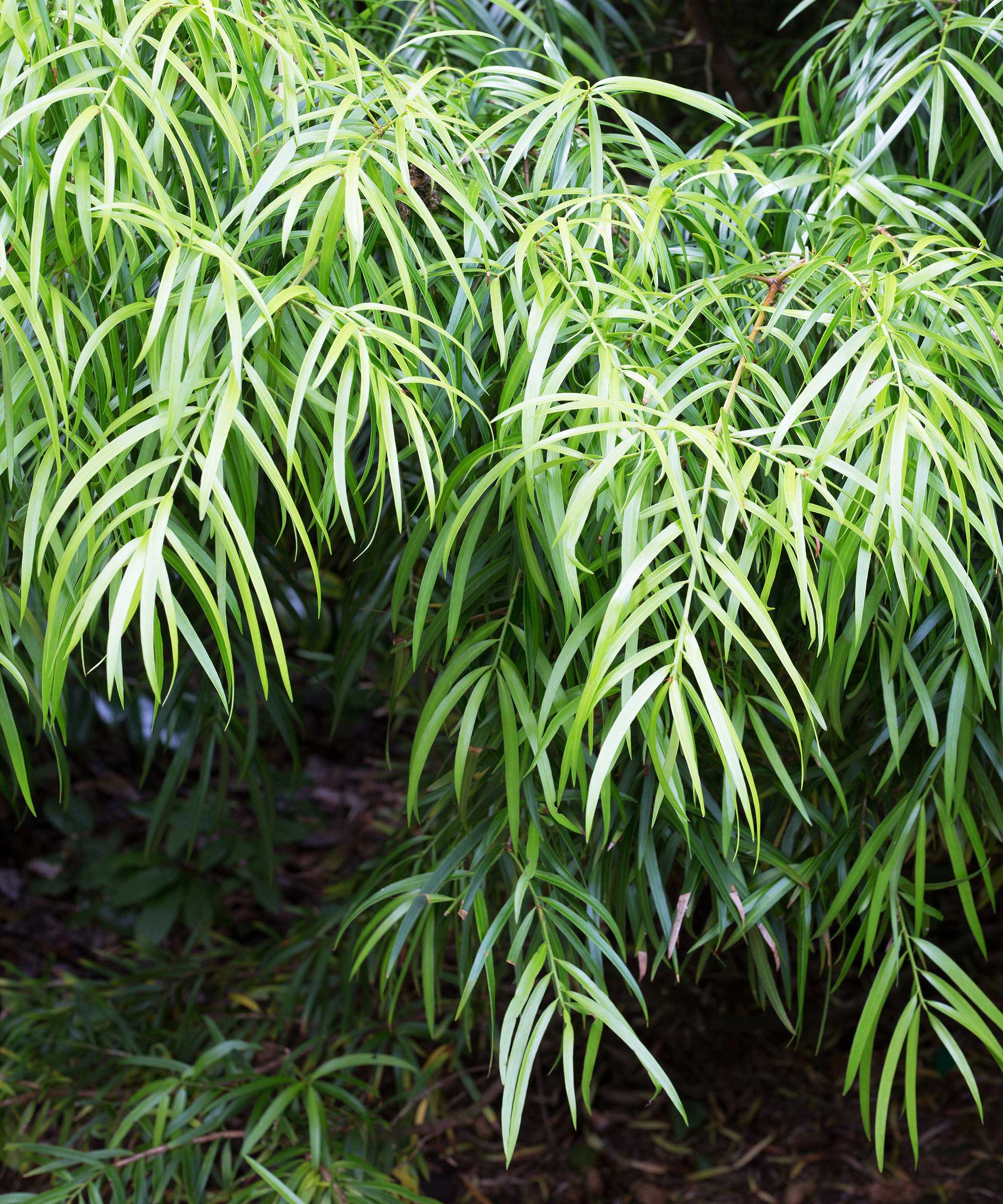
Podocarpus salignus has leaves similar to a willow
Common problems with podocarpus
Apart from the risk of cold winters to some of the Chilean and South African species, podocarpus are as risk-free as almost any conifer genus, says the experts from Caerhays Garden.
This may be due to the resilience and hardiness which results from their nodular root systems, they explain. 'Like all conifers, podocarpus are very susceptible to spray drift (from pesticides), but that’s about it.'
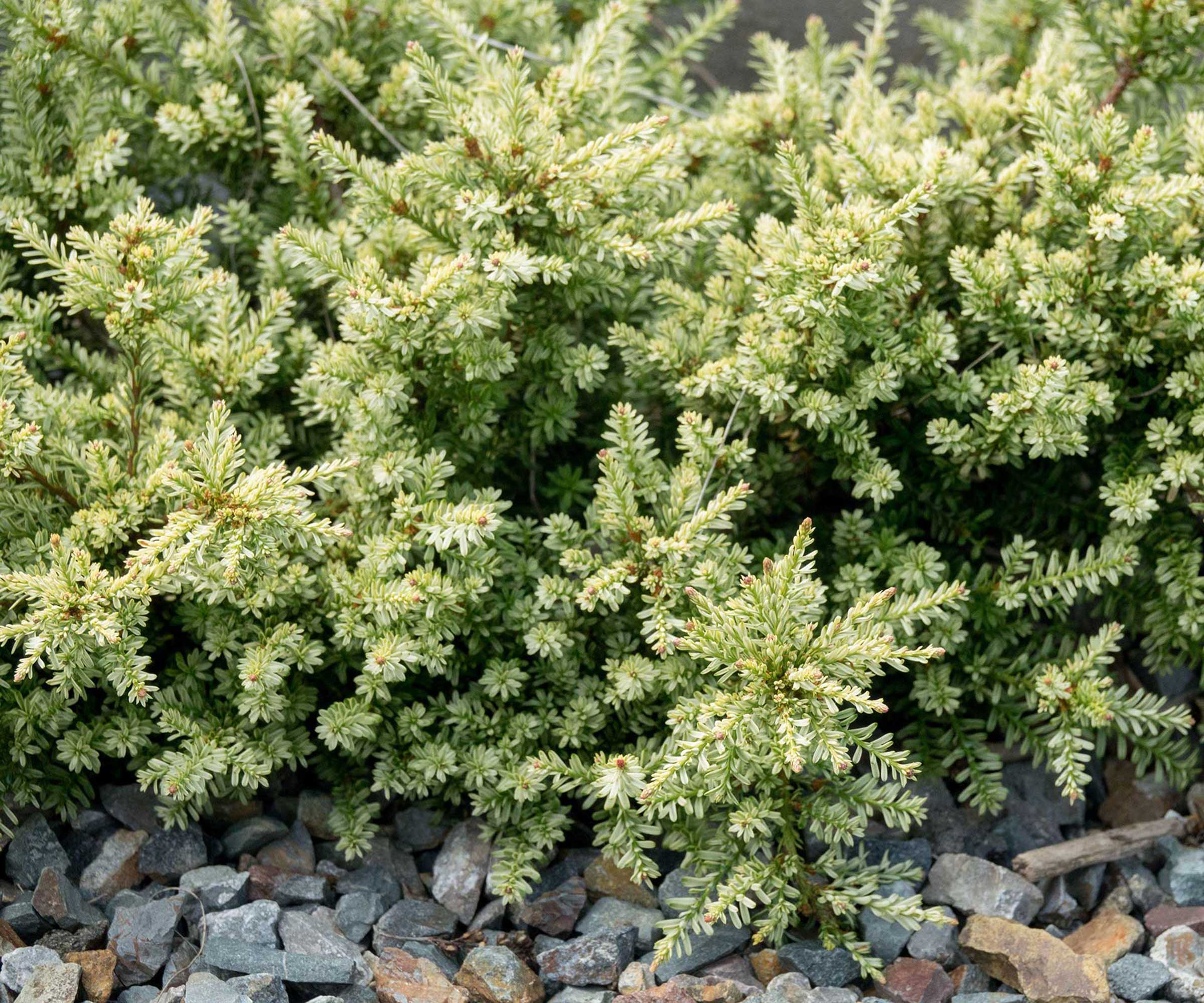
Podocarpus nivalis 'Kilworth Cream'
Are podocarpus fast-growing trees?
No, these are not fast-growing trees, as they only put on between 6-12in a year. However, most get tall eventually so it’s wise not to plant them too close to the house where they might grow up to the eaves or block the light to upstairs windows. Their roots are not particularly invasive and don’t push through sidewalks or patios, meaning you can plant them near walkways or structures.
Happily, their size can easily be kept in check with regular pruning, and, as mentioned, they’re great for turning into hedges or topiary.
Where to buy podocarpus plants
Fancy introducing a podocarpus to your backyard? These quicklinks will help start your search.
Sign up to the Homes & Gardens newsletter
Design expertise in your inbox – from inspiring decorating ideas and beautiful celebrity homes to practical gardening advice and shopping round-ups.

Sally is horticulturally trained to degree level and has worked on gardening magazines for over a decade. She now regularly writes for Homes & Gardens and Easy Gardens. When Sally isn’t writing, she gardens for local clients, and cultivates her own little patch in sunny Bournemouth.
-
 These are the 6 must-have colors to decorate with in April 2025
These are the 6 must-have colors to decorate with in April 2025What do retro-inspired yellows and beautiful blues all have in common? They're on our hot list for the season ahead
By Sophia Pouget de St Victor Published
-
 Plants never to grow next to fruit trees
Plants never to grow next to fruit treesExpert advice on which plants to keep away from fruit trees to encourage a healthy harvest
By Jacky Parker Published